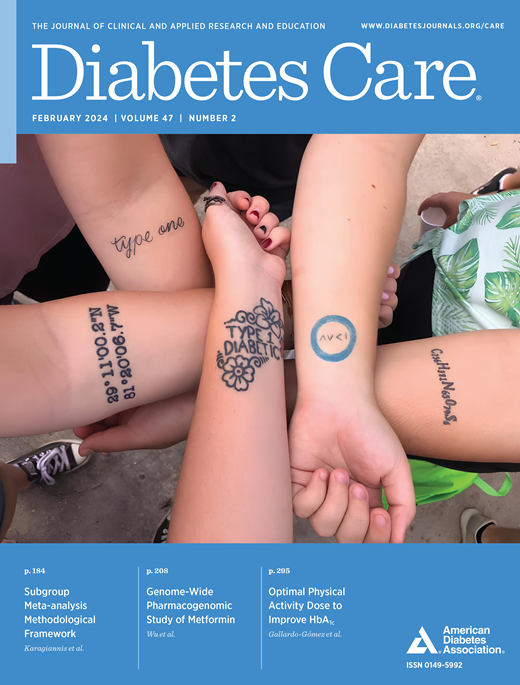不同时期的能量摄入和膳食血糖负荷与美国 2 型糖尿病患者心血管疾病死亡率的关系
IF 14.8
1区 医学
Q1 ENDOCRINOLOGY & METABOLISM
引用次数: 0
摘要
目的 研究 2 型糖尿病成人在一天中不同时段的能量摄入和血糖负荷 (GL) 与心血管疾病 (CVD) 死亡风险之间的关系。研究设计与方法 该队列研究纳入了参加 2003-2014 年美国国家健康与营养调查(基线)的 2,911 名成人糖尿病患者,以及通过与国家死亡指数连接获得的至 2019 年的心血管疾病死亡率数据。清晨(上午 6:00-7:59)、傍晚(上午 8:00-10:59)、下午(上午 11:00-下午 5:59)、傍晚(下午 6:00-11:59)和夜间(上午 0:00-5:59)的能量摄入量和 GL 均来自基线时的两次 24 小时饮食回忆。采用 Cox 模型估算心血管疾病死亡率的危险比(HRs),并对总能量摄入、饮食质量、社会人口学和生活方式特征以及医疗条件进行调整。结果 基线研究对象(51.8% 为女性,62.3% 为非西班牙裔白人)的平均年龄为 57.4 岁(SE,0.4)。中位随访时间为 9.3 年(四分位间范围 = 6.8,12.1),共记录了 190 例心血管疾病死亡病例。清晨晚些时候摄入的能量和 GL 与心血管疾病死亡风险成反比(能量摄入每增加 100 千卡,HR 0.90 [95% CI 0.83-0.98];GL 每增加 10 单位,HR 0.86 [95% CI 0.77-0.95])。相比之下,夜间能量摄入和 GL 与心血管疾病死亡风险呈正相关(每增加 100 千卡能量摄入,HR 1.22 [95% CI 1.07-1.40];每增加 10 单位 GL,HR 1.44 [95% CI 1.17-1.77])。结论 对于成人 2 型糖尿病患者来说,清晨晚些时候进食可能对心血管疾病死亡率有保护作用,而夜间进食则可能有害。本文章由计算机程序翻译,如有差异,请以英文原文为准。
Association of Energy Intake and Dietary Glycemic Load in Different Time Periods With Cardiovascular Disease Mortality Among U.S. Adults With Type 2 Diabetes
OBJECTIVE To examine the associations of energy intake and glycemic load (GL) in different time periods during the day with cardiovascular disease (CVD) mortality risk in adults with type 2 diabetes. RESEARCH DESIGN AND METHODS This cohort study included 2,911 adults with diabetes from who were part of the U.S. National Health and Nutrition Examination Survey 2003–2014 (baseline), and CVD mortality data obtained by linkage to the National Death Index through 2019. Energy intake and GL in early morning (6:00–7:59 a.m.), late morning (8:00–10:59 a.m.), afternoon (11:00 a.m.–5:59 p.m.), evening (6:00–11:59 p.m.), and night (0:00–5:59 a.m.) were derived from two 24-h dietary recalls at baseline. Cox models were used to estimate hazard ratios (HRs) for CVD mortality, adjusted for total energy intake, diet quality, sociodemographic and lifestyle characteristics, and medical conditions. RESULTS At baseline, the study population (51.8% female, 62.3% non-Hispanic White) had a mean age of 57.4 (SE, 0.4) years. Over a median follow-up of 9.3 (interquartile range = 6.8, 12.1) years, 190 CVD deaths were documented. Energy intake and GL in late morning were inversely associated with CVD mortality risk (per 100-kcal energy intake increment, HR 0.90 [95% CI 0.83–0.98]; per 10-unit GL increment, HR 0.86 [95% CI 0.77–0.95]). In contrast, energy intake and GL at night were positively associated with CVD mortality risk (per 100-kcal energy intake increment, HR 1.22 [95% CI 1.07–1.40]; per 10-unit GL increment, HR 1.44 [95% CI 1.17–1.77]). CONCLUSIONS For adults with type 2 diabetes, late morning may be a protective eating time against CVD mortality, whereas night may be a detrimental eating time.
求助全文
通过发布文献求助,成功后即可免费获取论文全文。
去求助
来源期刊

Diabetes Care
医学-内分泌学与代谢
CiteScore
27.80
自引率
4.90%
发文量
449
审稿时长
1 months
期刊介绍:
The journal's overarching mission can be captured by the simple word "Care," reflecting its commitment to enhancing patient well-being. Diabetes Care aims to support better patient care by addressing the comprehensive needs of healthcare professionals dedicated to managing diabetes.
Diabetes Care serves as a valuable resource for healthcare practitioners, aiming to advance knowledge, foster research, and improve diabetes management. The journal publishes original research across various categories, including Clinical Care, Education, Nutrition, Psychosocial Research, Epidemiology, Health Services Research, Emerging Treatments and Technologies, Pathophysiology, Complications, and Cardiovascular and Metabolic Risk. Additionally, Diabetes Care features ADA statements, consensus reports, review articles, letters to the editor, and health/medical news, appealing to a diverse audience of physicians, researchers, psychologists, educators, and other healthcare professionals.
 求助内容:
求助内容: 应助结果提醒方式:
应助结果提醒方式:


